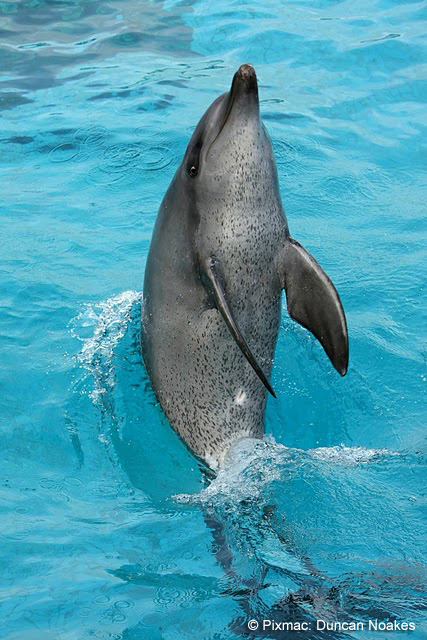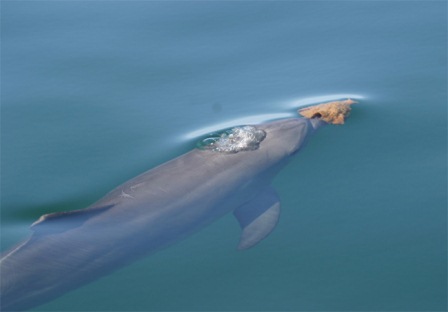Dolphin Society and Culture
Imagine growing up in the very different world of the ocean
Dolphins and UsPart One: The Smartest of Us All? “So Long, and Thanks for All the Fish!” Amazing Abilities of Dolphins Dolphins or Humans: Who’s Smarter? Dolphin Society and Culture They’re Super-Brainy, Too More Fascinating Stuff The Great Researcher A Society that Works Are Dolphins “Persons” Life and Culture How Smart is a Dolphin? Experimenting on Dolphins My Visit to the Dolphins Other Links & Videos Mirror Self-Recognition Test The Herman Investigation The Minds of Whales |
 In an ocean environment, you need to pick up cues from your mates in a nano-second, stay in touch with your scouts, and operate with split-second timing as a group. (Again, you can see how good dolphins are at all of this in those David Attenborough BBC videos.)
In an ocean environment, you need to pick up cues from your mates in a nano-second, stay in touch with your scouts, and operate with split-second timing as a group. (Again, you can see how good dolphins are at all of this in those David Attenborough BBC videos.)
Dolphins have developed ways of communicating that outstrip humans. Prime among these is the way they use echolocation. It’s super-sophisticated. They can do a lot more than just tell how far away something is.
They can tell what it’s made of, “see” inside it, and “feel” the texture of it. It’s as if we had x-ray eyesight.
They can use echolocation as a way of “seeing” what a fellow dolphin is seeing. They do this by tuning into each other’s echo-locations. So if I’m checking something out with my “X-ray” sonar, you can pick up the signal and share the whole experience.
The dolphin version of the Second Amendment
They can also use the sounds and signals they send out in lots of other ways — tender ways and aggressive ways. One of the leading experts on echolocation among cetaceans (dolphins and whales) is Hal Whitehead, a scientist at Dalhousie University in Canada, who spends weeks at sea with his team collecting acoustic, visual, photographic and oceanographic data to analyze.
Hal was one of the earliest people to discover how cetaceans can use sound beams to stun their prey and attack their enemies. They can easily kill a large animal with one acoustic blast. It’s like they’re all armed with hi-tech machine guns. So, how come they’re so peaceable with each other when it would be so easy for one of them to inflict a death-blow on another without even being noticed? While we humans wrestle with gang warfare, gun laws, Second Amendment rights, and sport hunting — not to mention full scale, devastating wars among our own species — dolphins and whales have clearly developed an entirely different culture. They’re armed and dangerous … yet they live at peace with each other, and they pass this way of life on to their young. That’s the very definition of an advanced society and culture.
Some people have even suggested that when we humans feel a heightened sense of emotion and understanding when we’re close to dolphins in the wild, maybe they’re echo-locating on us and we’re feeling those vibrations without being quite aware of what’s happening.
Their culture and ours
Dolphins also spend a lot of time educating their children — and each other. They’re always learning new things and passing them on. A fascinating example of this is how an injured dolphin, who was taken to a theme park for veterinary treatment, spent some time watching other dolphins learning a particular trick from their trainers. She must have thought it was quite a cool trick, because when she was returned to the wild, she proceeded to teach it to her friends and family. Scientists photographed her showing her pals the art of tail-walking, and they all started doing it together.

This dolphin is using a sponge to help her dig into the ocean floor for a tasty treat without hurting her nose. It’s a behavior she subsequently passed on to other members of the family.
Hal Whitehead has studied cetaceans all over the world. “The more we look at them,” he says, “the more it seems that a very large part of their behavior is learned from each other. Different groups behave in different ways. That’s culture.”
Hal also notes that culture can operate in different ways. It can be a force for progress, but also for lack of progress. “If you look at human culture, it allows us to do extraordinary things and it changes very fast. As the environment changes, we figure out new ways to do things and pass them on and elaborate them and so on. On the other hand, culture can also be a force for conformism and conservatism, and so sometimes we don’t do the important things because our culture holds us back.”
Hal has observed how some cetaceans adapt rapidly to changing conditions in the oceans — long-line fishing, pollution, climate change, etc. “Just like with us humans, you see the same with the whales. In some circumstances, they figure out new ways of dealing with the way the oceans have changed, and in others they aren’t terribly adaptable.”
Passing on what you’ve learned to each other and to the next generation is the basis of what we call culture. And dolphins have very sophisticated cultures. Philippa Brakes is a marine biologist who lives in New Zealand who has spent many years studying dolphin society and culture. We asked her what she thinks it must be like being a dolphin and what, if she had a chance, she’d most like to ask dolphins. You can read our interview with Philippa, and learn more about dolphin culture and society, here.
